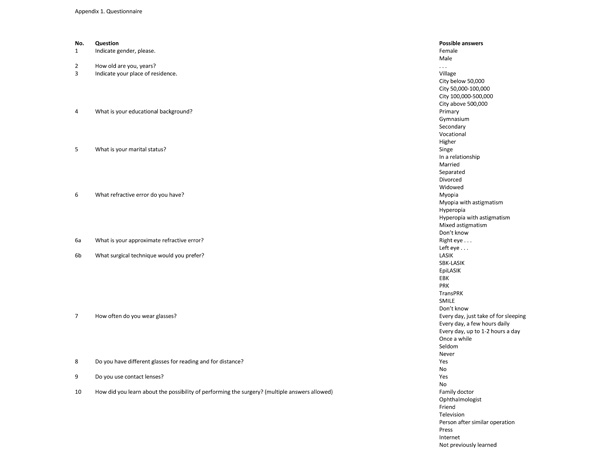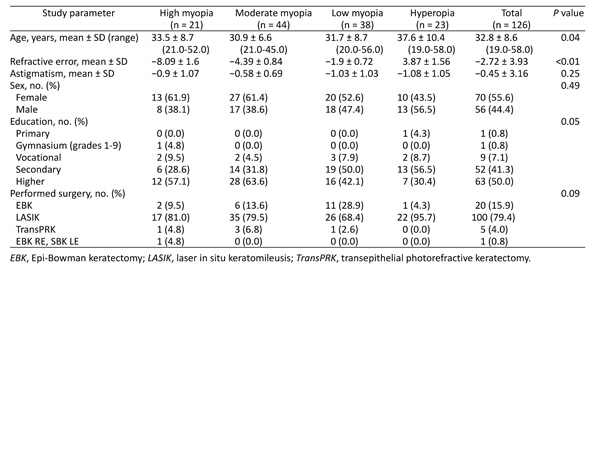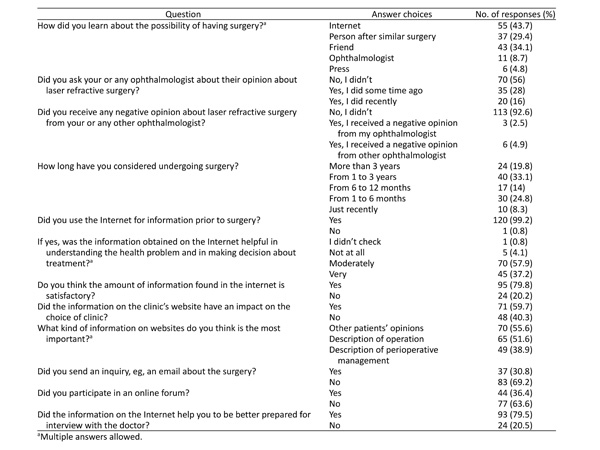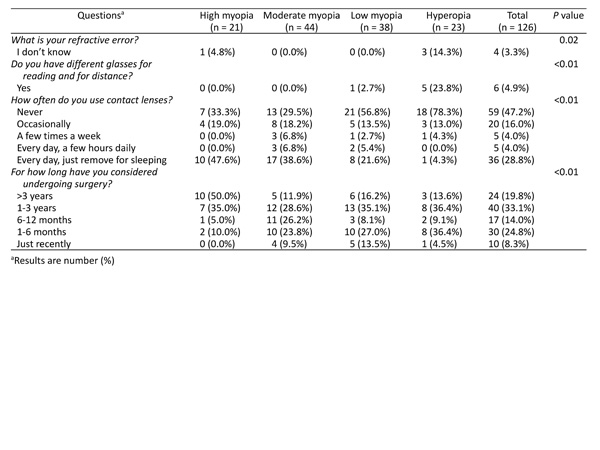|
|
 |
 |
 |
 |
|
|
Information sources for patients undergoing corneal refractive surgery: results from a cross-sectional patient survey from a single private center in Poland
Digital Journal of Ophthalmology 2021
Volume 27, Number 1
March 19, 2021
DOI: 10.5693/djo.01.2021.01.001
|
Printer Friendly
Download PDF |



Katarzyna Przewłócka, BSc | Hygeia Clinic, Gdańsk, Poland Piotr Kanclerz | ArtLife Ophthalmological Center, Gdańsk, Poland
|
|
|
| Abstract | Purpose
To identify the information sources for patients undergoing laser vision correction.
Methods
Individuals who underwent corneal refractive surgery at a private practice from December 2017 to August 2018 and agreed to complete an anonymous questionnaire were included. The manifest refraction and surgical method was recorded and correlated with the questionnaire results.
Results
Data collected from 126 patients (mean age, 32.8 ± 8.6 years; 55.6% women) were analyzed. Of 121 patients, 120 (99.2%) identified the Internet as a source for information on refractive surgery, and 71 of 119 (59.7%) noted that the clinic’s website influenced their choice of clinic. Patients with high myopia more commonly used contact lenses and had considered undergoing refractive surgery for a longer time compared with patients with other refractive errors (P < 0.01 and P < 0.01, resp.). Patients with hyperopia were less likely to know their own refractive error (P = 0.02).
Conclusions
In this patient cohort, the Internet was the main source of information for those undergoing refractive surgery. | | | Introduction | | In 2016, it was estimated that almost half of the world’s population was using the Internet; coverage is over 80% in developed countries and just less than 40% in developing countries.(1) An increasing number of people use it for information about health issues.(2) However, very few studies have analyzed the effect of widespread Internet use on the information sources and decision making of patients undergoing elective ophthalmic surgery. The aim of the current study was to identify the information sources used by patients undergoing corneal refractive surgery and to investigate the role the Internet-based information played in patients’ decision making. | | | Materials and Methods | Patients who underwent corneal refractive surgery at a private practice in Poland (ArtLife Ophthalmological Center, Gdańsk, Poland) from December 2017 to August 2018 were included. This practice focuses solely on refractive surgery (superficial ablations and manual microkeratome LASIK), and the preferred surgical method is thin-flap LASIK. The study adhered to the tenets of the Declaration of Helsinki, and the study protocol was approved by the bioethics committee (Komisja Bioetyczna przy Okręgowej Izbie Lekarskiej w Gdańsku; KB-31/17). Informed consent was obtained from all participants.
Consecutive patients were asked to complete an anonymous questionnaire, which included free-text and multiple-choice questions on demographics, refractive status, and their decision to undergo surgery (Appendix 1). The questions, written in Polish, were developed by the authors using published methods.(3) In all cases, the questionnaire was filled out after arriving at the center but before any medical consultation. A questionnaire was excluded from the analysis if the patient did not enter age and sex or did not answer at least half of the questions. Along with the questionnaire, the manifest refraction and surgical method were recorded for each patient. Patients were classified based on spherical equivalent of the manifest refractive error in the most ametropic eye as low myopia (from −0.25 D to −3.0 D), moderate myopia (from −3.25 to −6.0 D), high myopia (over −6.0 D), and hyperopia (+0.25 D and over). Astigmatism was defined as a cylinder power −0.75 D. The results from the questionnaire were tallied with the manifest refractive error.
Open Source Statistics for Public Health application(4) and Statistica 12.0 (Dell Software, Round Rock, TX) were used for statistical analyis. The Shapiro-Wilk test for normality was applied to assess the distribution of continuous parameters. Differences among categorical data were analyzed using the χ2 test; for continuous data the Kruskal-Wallis test was applied. A P value of <0.05 was considered statistically significant. Approximately 280 patients undergo surgery in the center annually; assuming that the response distribution is 70%, for a 5% margin of error and a confidence level of 90% the representative sample size was estimated at 125 participants. | |

Appendix 1, page 1
Questionnaire
|
|

Appendix 1, page 2
Questionnaire
|
|
| Results | A total of 160 complete questionnaires were collected from individuals undergoing preoperative evaluation. Nobody declined to complete the form, and all acquired forms were considered valid. As 34 patients were not considered eligible to undergo surgery, the results of 126 completed questionnaires were analyzed. The mean age of patients (with standard deviation) was 32.8 ± 8.6 years. Women represented 55.6% of the patients in this study. Characteristics of the patients are presented in Table 1. Bilateral surgery was performed in 119 patients (94.4%), whereas a unilateral procedure was performed in 7 eyes (3 right and 4 left).
Results of questionnaires are summarized in Table 2. Of the respondents, 96% believed that the Internet was their main source of information before the consultation. The vast majority of patients (96.7%) knew their own spherical refractive error. Of the 160 patients, 56 had astigmatism in their manifest refraction; only 18 individuals knew that they had astigmatism, and 8 knew their cylinder power. With regard to when patients decided to pursue the idea of undergoing refractive surgery, for 34.1% of patients it was after talking to a friend; for 29.4%, after talking with another person who underwent such a surgery; and for 43.7% and 8.7%, respectively, it was after finding information on the Internet or consulting with an ophthalmologist. Almost all patients (99.2%) used the Internet for information on refractive surgery before the consultation, and 79.8% of participants believed that the amount of information they found online was satisfactory. In most cases, knowledge from the Internet was very (37.2%) or moderately (57.9%) helpful in understanding the health problem and in making the decision to pursue surgery.
Differences in the responses to the questions according to refractive error groups are presented in Table 3. Individuals with hyperopia were less likely to know their refractive error (P = 0.02; χ2 = 10.15; dF = 3) and were more likely to know different glasses for distance and reading (P < 0.01; χ2 = 19.93; dF = 3). Patients with high myopia were more likely to have used contact lenses compared to those with moderate myopia, low myopia, and hyperopia (P < 0.01). High myopia patients also more commonly considered undergoing refractive surgery for a longer time than other refractive groups (P < 0.01). | |

Table 1.
Patient characteristics
|
|

Table 2.
Information sources for laser refractive surgery
|
|

Table 3.
Differences between refractive error groups
|
|
| Discussion | Traditionally, the most important means for patients to obtain knowledge about health was by direct contact with a specialist.(5) In our study, 44% of patients had asked an ophthalmologist for advice on corneal refractive surgery before the consultation, and only 4.8% felt that contact with a doctor was the main source of their information before coming for the consultation. Our results indicate that the Internet was perceived as the main source of information for current patients undergoing laser vision correction. This is in contrast to other studies, which have reported significantly lower importance of the Internet; in one study, the Internet was the informal source of information in 23% of parents of children with ophthalmic diseases(6) and for 36.2%-58.1% in plastic surgery patients.(7,8) The relative importance of the Internet for the patients in our study could partially be explained by the relatively young patient age in our study (32.8 ± 8.6 years) as well as to the high Internet penetration in Poland.
Almost 80% of patients indicated that the information they found on the Internet helped them prepare for the surgical consultation. Our study also suggests that there is a high demand for authoritative online health information that can help patients to be more critical about information obtained directly from consultation with their ophthalmologists. An increasing number of government and medical institutions as well as business corporations have established health knowledge information portals to provide public health information.(9) The reliability of information on these websites could potentially be influenced by several factors. One investigation reported that medical information found on Wikipedia is more complete and accurate compared to other freely available Internet information sources, including clinic Web pages.(2) Another study has shown that the quality of refractive surgery YouTube.com videos is generally poor and might contain fragmentary information.(10) Moreover, Desai et al reported that videos with better educational content did not engage users more than low-quality videos.(11) Several instruments were developed to rate health information found on the Internet; however, their ratings cannot be considered unbiased.(12) Based on our findings, we recommend that information for patient education presented on websites should be scrupulously prepared, show evidence-based data, and undergo critical review. That is, patient educational texts should undergo peer review, and the fact of the text’s having undergone a process of unbiased expert review should be attested for healthcare consumers. Furthermore, high-quality sources with greater educational content should be favored by search engines over popular videos. Attention must also be paid to health literacy level, because high-quality educational materials are commonly written at a level too high for many patients to understand.(13)
There are several limitations of this study. First, it was performed at a single center and is likely representative of our particular clinic population, but it may not reflect patient populations at other refractive surgery centers in Poland and worldwide. Patients presenting at different clinics may have different information sources, for example, depending on the marketing strategy of the clinic. In developing countries with more limited Internet access, the information sources may be different. Second, we did not ask for detailed information regarding specific Internet content patients consulted preoperatively. At the time of this study, our center had a website and Facebook profile, but it did not have a YouTube channel. Another limitation is that, because only patients who underwent surgery were included, the effect of Internet-based information on the decision to undergo surgery was not directly determined. Lastly, the questionnaire was not validated. The questionnaires were completed before the preoperative consultation, so the adequacy of the information found on the Internet could not be compared with information obtained at the surgical consultation. | | | Acknowledgements | The authors thank Dr. Jullia Rosdahl for the Department of Ophthalmology, Duke University School of Medicine, Durham, NC, USA, for a critical discussion of the current work and language edits.
Dr. Kanclerz receives nonfinancial support from Visim and Optopol Technology. | | | References | 1. Individuals using the Internet (% of population) | Data. Accessed October 24, 2018. https://data.worldbank.org/indicator/IT.NET.USER.ZS.
2. Ivastinovic D, Wackernagel W, Wedrich A. Accuracy of freely available information about rhegmatogenous retinal detachment on the Internet. JAMA Ophthalmol 2019;137:113-14.
3. Johnson RL, Morgan GB. Item types, response formats, and consequences for statistical investigations. In: Schweizer K, DiStefano C, eds. Principles and Methods of Test Construction: Standards and Recent Advances. Hogrefe Publishing; 2016:83-104.
4. Open Source Statistics for Public Health. http://openepi.com. Accessed October 24, 2018.
5. Kassirer JP. Patients, physicians, and the Internet. Health Aff 2000;19:115-23.
6. Rahi JS, Manaras I, Barr K. Information sources and their use by parents of children with ophthalmic disorders. Invest Ophthalmol Vis Sci 2003;44:2457-60.
7. Parmeshwar N, Reid CM, Park AJ, Brandel MG, Dobke MK, Gosman AA. Evaluation of information sources in plastic surgery decision-making. Cureus 2018;10:e2773.
8. Szychta P, Zieli?ski T, Ryka?a J, Kruk-Jeromin J. The Internet as a Source of Information for Patients Prior to Rhinoplasty. Clin Exp Otorhinolaryngol 2011;4:131.
9. Lu X, Zhang R, Wu W, Shang X, Liu M. Relationship between Internet health information and patient compliance based on trust: empirical study. J Med Internet Res 2018;20:e253.
10. Kuçuk B, Sirakaya E. An Analysis of YouTube Videos as Educational Resources for Patients About Refractive Surgery. Cornea 2020;39:491-4.
11. Desai T, Shariff A, Dhingra V, Minhas D, Eure M, Kats M. Is content really king? An objective analysis of the public’s response to medical videos on YouTube. PLoS One 2013;8:e82469.
12. Jadad AR, Gagliardi A. Rating Health Information on the Internet. JAMA 1998;279:611.
13. Williams AM, Muir KW, Rosdahl JA. Readability of patient education materials in ophthalmology: a single-institution study and systematic review. BMC Ophthalmol 2016;16:133. | |
|
 |
 |
 |

|
|
 Welcome, please sign in
Welcome, please sign in  Welcome, please sign in
Welcome, please sign in